Wildflowers, Grasses and Other Nonwoody Plants
Media
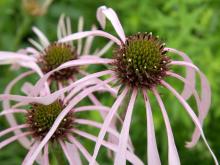
Species Types
Scientific Name
Echinacea pallida
Description
One of Missouri's five types of echinacea, pale purple coneflower is distinguished by its white pollen, drooping pink or purple ray flowers, and narrow, tapering leaves. It occurs nearly statewide, except for the Bootheel lowlands.
Media
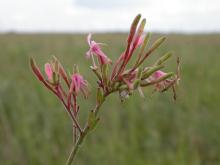
Species Types
Scientific Name
Oenothera filiformis (formerly Gaura longiflora, G. biennis)
Description
Large-flowered gaura is a tall plant whose white flowers turn pinkish as they age. Four petals point upward, then bend back, and 8 stamens droop downward. The flowers look something like small butterflies.
Media
Species Types
Scientific Name
Erigeron philadelphicus
Description
The antique belief that this plant might repel fleas gives the fleabanes their name. There are more than 170 fleabanes in the genus Erigeron in North America. This one is scattered to common nearly throughout Missouri. Native Americans used this species medicinally for a variety of ailments.
Media
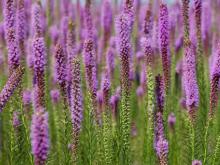
Species Types
Scientific Name
Liatris pycnostachya
Description
Prairie blazing star has an unbranched stalk with many densely crowded, rose-purple flowerheads. It is a signature wildflower of the tallgrass prairie.
Media

Species Types
Scientific Name
Asclepias verticillata
Description
Whorled milkweed has rounded clusters of small white flowers. The leaves are soft, threadlike, and grow in whorls from the stem. It occurs in upland prairies and fields.
Media

Species Types
Scientific Name
Veronicastrum virginicum
Description
Culver’s root is a tall, graceful perennial with flower clusters that look like candelabras. The white flowers are packed together in slender, brushlike spikes. The leaves are in whorls, well-spaced along the stalk.
Media

Species Types
Scientific Name
Symphyotrichum spp. (formerly Aster spp.)
Description
Missouri has 24 species of New World asters in genus Symphyotrichum. Most have purple or white ray flowers and yellow disk flowers that turn reddish over time. Most bloom in late summer and fall.
Media
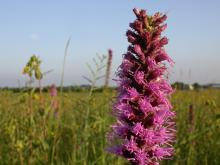
Species Types
Scientific Name
Liatris spp.
Description
Missouri boasts nine native species of blazing stars, or gayfeathers, in genus Liatris. These showy, upright, unbranching spikes of magenta-pink wildflowers bloom in sunny habitats.
Media

Species Types
Scientific Name
Liatris cylindracea
Description
Cylindrical blazing star is one of several Missouri native species of blazing stars, or gayfeathers. It is widely scattered in the Ozarks and eastern Missouri. Identify it by its bracts, which are pressed against the base of the flowerhead, accentuating its cylindrical look.
Media
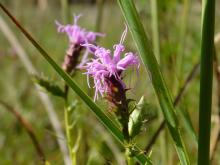
Species Types
Scientific Name
Liatris squarrosa (syn. L. hirsuta, in part)
Description
Scaly blazing star is one of several Missouri native species of blazing stars, or gayfeathers. It is scattered nearly statewide. Identify it by its long-pointed flowerhead bracts that spread or curl sharply away.
See Also
About Wildflowers, Grasses and Other Nonwoody Plants in Missouri
A very simple way of thinking about the green world is to divide the vascular plants into two groups: woody and nonwoody (or herbaceous). But this is an artificial division; many plant families include some species that are woody and some that are not. The diversity of nonwoody vascular plants is staggering! Think of all the ferns, grasses, sedges, lilies, peas, sunflowers, nightshades, milkweeds, mustards, mints, and mallows — weeds and wildflowers — and many more!





















